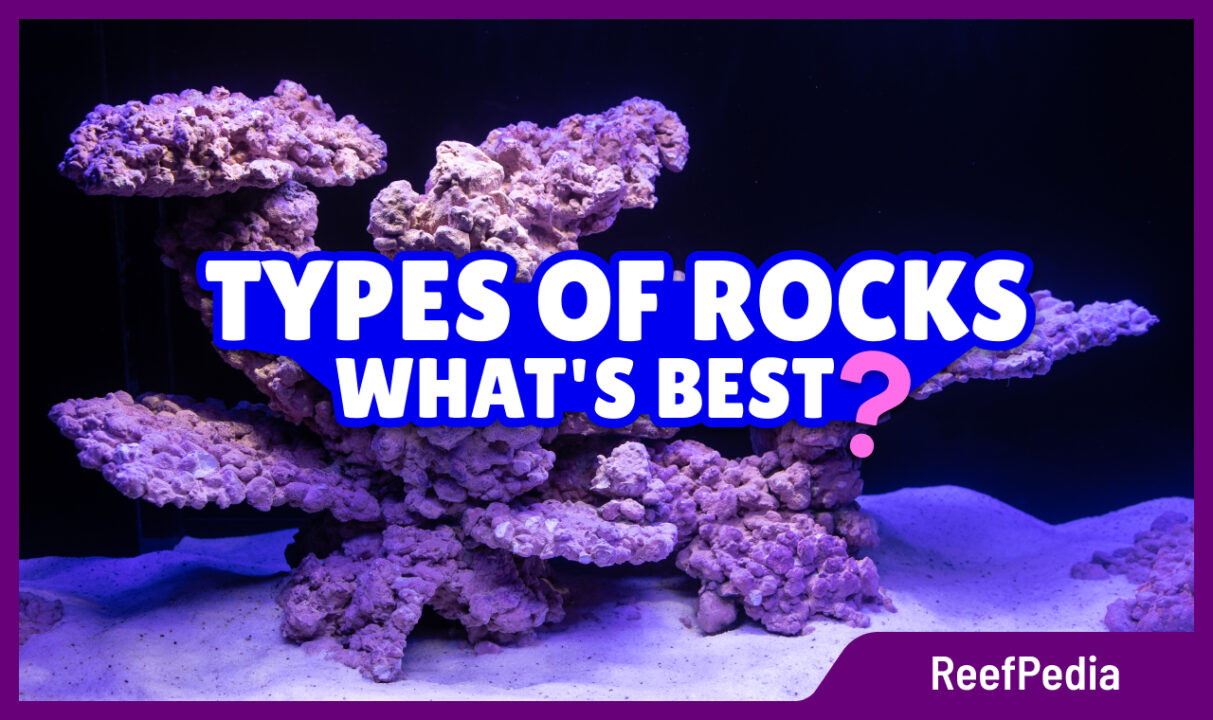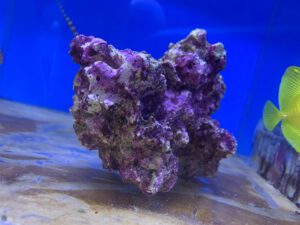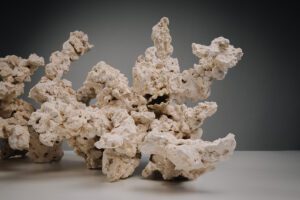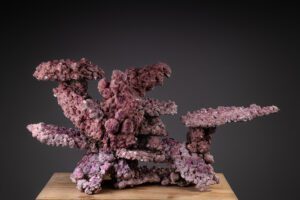Table of Contents
One of the main items on the list of things to do when setting up an aquarium is rocks. When you decide to create a marine aquarium, you should bear in mind that you are recreating a specific microclimate for the animals living in the water. It is difficult to imagine a marine aquarium without porous rocks, although, of course, it is possible.
What are these rocks actually for?
Looking from a visual perspective, having and arranging rocks in the aquarium significantly affects its design, and thus the visual effect that will please more than one eye in the future.
You need to know that the role of rocks in a marine aquarium is not just about the visual effect. First of all, they are responsible for the biofiltration of salt water, and also provide shelter for small fish and invertebrate animals. And the choice of rock is important for various reasons, as will be discussed later in the article.
Types of rocks and their selection for your aquarium?
Wanting to ensure optimal conditions for the development of corals, you must provide them with, among other things, an optimal foundation, i.e. rocks. Not so long ago it was recommended that they should make up as much as approx. 20% of the water volume. This recommendation was related to the fact that it used to be the main source of biofiltration. As a result, most of the space in a marine aquarium was simply filled with rock.
Today, the rock is not the only element of the marine aquarium responsible for biofiltration. The presence of devices such as skimmers or algae filters, as well as preparations with bacteria, support this process. The result is that the role of the rock can be minimized mainly to the structure under the corals. However, when planning the stocking, it is worth remembering that proliferating corals will sooner or later cover it up. Rock cannot be overdone, so there are no limits on the maximum amount of rock in the tank. Although, the choice of the type of rock carries certain consequences (table) that you need to keep in mind when choosing it. Currently, it is recommended that the rock occupy about 10% of the volume of the aquarium. Where a simplified scheme of 10 kg of rock per 100L of marine aquarium can be adopted.
Type of rocks
In marine aquaristics, there are mainly 3 types of rocks, and each of them has a different origin of formation, they differ in appearance, porosity, chemical composition as well as biological:
- live rocks
- natural dry rocks (extracted from the oceans)
- synthetic dry rocks
Aquarium aspects | LIVING ROCK | NATURAL DRY ROCK | ARTIFICIAL DRY ROCK |
Reproduction of the ecosystem for animals (appearance) | 100% natural (coral reefs) | Rocks with fossil elements of ancient marine life | Artificial, 100% man-made |
Presence of bacteria | Presence of various species of nitrifying and denitrifying bacteria | No presence of bacteria | No presence of bacteria |
Presence of organisms other than bacteria | Algae, corals, serpentines, as well as many other forms of life can be found on the surface of the rock | It is deprived of any organisms such as polychaetes, algae, and Convolutriloba retrogemma | It is deprived of any organisms such as polychaetes, algae, and Convolutriloba retrogemma |
Biofiltration efficiency | Very good | Longer than with live rock | Varies from manufacturer to manufacturer, biological filtration readiness longer than with live rock |
Marine aquarium maturation process? | Fast | Moderate | Depending on the manufacturer, can match dry natural rock |
 Living rock
Living rock
Is part of a coral reef, which is made up of dead calcareous coral skeletons. The process of corals growing and dying, which takes many years, provides an opportunity to find the optimal place for new corals to grow. In the wild, corals grow on the skeletons of their ancestors.
It is obtained from prehistoric coral seas. Fragments of various sizes and different shapes are available. From small ones about 10 centimetres in diameter, through medium ones of 20 centimetres, to larger ones reaching 30-40 centimetres. All fragments can be combined with glue, creating interesting spatial arrangements, in the shape of a natural coral reef.
On the surface of the rock you can find algae, corals, snakeheads, as well as many other forms of life that enter your aquarium with it. Live rock is characterised by lightness and high porosity, and its placement in a marine tank provides the greatest reflection of the natural ecosystem. This is possible due to the presence of various species of nitrifying and denitrifying bacteria, which break down organic matter. To ensure that the rock does not lose its valuable properties, it is important to make sure that it is constantly in the aquarium circuit to ensure proper temperature and water circulation.
Live rock is fragments of coral reefs. Nowadays, it is becoming increasingly difficult to purchase good quality live rock, as less and less of it is being transported to Europe – this is due to the restrictive approach to environmental protection.
 Natural dry rocks
Natural dry rocks
Also available on the market are natural dry rocks that come in the form of lumps and shelves, which contain fossils of ancient marine life. In order to obtain this type of product, the rock is placed in ocean water for several or dozens of weeks, during which the gradual overgrowth of the stone with various types of organisms takes place.
Dry natural sea rock is fully bioactive, and this makes it an excellent substitute for the living version. It is an environmentally friendly man-made rock. In general, dry natural rock differs from living rock only in that it has been dried out and no longer has life on it like living rock. It will take longer to mature with this type of rock compared to live rock, and you need to take proper care of the process of supplying bacteria. It is also hard to buy it in stores nowadays.
Synthetic dry rock
The third alternative is to buy handmade synthetic dry rock, which is devoid of any organisms. In this case, we need to initiate biological filtration using strains of bacteria that will help the maturation process (which involves achieving a balance between consumers and food). This is very important for the proper functioning of the entire ecosystem located in a saltwater aquarium.
The rock is dry, so we can easily glue it together, creating impressive decorations, even before putting it in the tank. Most often it is produced from materials that correspond in composition to natural, living rock, although it can also be ceramic. Different manufacturers take different approaches to the production of such rocks, so it is worth getting more information before buying.
The types of rock mentioned are characterised by high porosity, which provides favourable conditions for the development of aerobic and anaerobic bacteria. Artificial as well as dry rock are not colonised by marine organisms found on living rocks. On the other hand, we have a guarantee that with them, to the aquarium, we will not bring unwanted tenants: crabs, mantis shrimps, polychaetes, whirlpools or algae.
How to properly arrange the rock?
First of all, remember that the arrangement of rocks can not be random, it matters, among other things, for the proper circulation of seawater.

When arranging rocks, pay special attention to several issues:
- Choose the right type of rock
- Provide the right amount of rock to fully play its role, it should occupy about 10% of the volume of the marine aquarium
- Arrange the rocks before glueing them together in such a way as to maintain spaces between the various formations through which animals can pass and proper water circulation takes place
- Glue the rocks together to ensure a stable structure
About author

Magdalena Metzler
Privately, I am a mother and a lover of nature and sport. My main interest is quantum chemistry, which hides a whole lot of unsolved mysteries and connections, which is extremely exciting from a scientific point of view.
In my scientific career, I have conducted international projects focused on innovative solutions for many branches of business, e.g. automotive, construction, and now, of course, marine aquaristics.
Working at Reef Factory gave me a passion for marine aquaristics, which I can develop every day, building a chemistry department and creating products that will help aquarists take care of tanks and ensure the highest safety of animals. One of the most exciting memories of working at Reef Factory is the commissioning of the ICP-OES spectrometer, which analyzes the elemental composition of seawater. The method of analysis in ICP is based on an analytical technique, which is a combination of my passion for quantum chemistry and marine aquaristics.
I hope you find my articles on ReefPedia interesting and helpful! Happy reading :))


 Living rock
Living rock  Natural dry rocks
Natural dry rocks